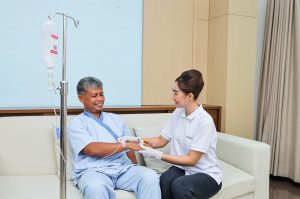The orthopneic position is one of the key patient lying positions that must be considered during surgical procedures or other medical treatments. There are various types of patient lying positions, one of which is the orthopneic position.

The orthopneic position involves the patient sitting slightly leaning forward, with their arms resting on an overbed table or their knees. This position is also known as the tripod position.
The orthopneic position is named after the condition known as orthopnea, which refers to difficulty breathing while lying down, as this position helps alleviate the symptoms of orthopnea. The term “orthopnea” comes from two Greek words: “ortho,” meaning upright or vertical, and “pnea,” meaning breathing.
When is the Orthopneic Position Used?
The orthopneic position is particularly beneficial for patients experiencing shortness of breath (dyspnea), especially when lying down, a condition known as orthopnea.
When a person is lying flat, gravity causes increased venous return from the legs and abdominal organs toward the heart, which results in higher pressure within the capillaries. In most people, this change in blood pressure does not cause symptoms.
However, in individuals with certain health conditions such as heart failure or chronic kidney disease, this can lead to fluid accumulation, which results in pulmonary edema and lowered oxygen levels in the blood, causing orthopnea.
Orthopnea can be caused by various factors, including excess fluid in the lungs, fluid buildup around the lungs or abdomen, chronic pneumonia, obesity, and diaphragm paralysis. Some symptoms of orthopnea that should be watched for include:
- Swelling in the feet and ankles
- Wheezing (a high-pitched sound when breathing)
- Unusual fatigue
- Paroxysmal nocturnal dyspnea (PND), or sudden shortness of breath that occurs when the patient awakens from sleep
- Frequent, unusual coughing
- Occasional chest pain
The orthopneic position helps expand the lungs’ capacity to their maximum, which allows for easier breathing. In heart failure patients, this position assists in redistributing blood pressure from the heart and lungs to the legs and abdominal organs, preventing pulmonary edema.
In addition to increasing lung capacity, the orthopneic position can prevent further lung damage. When done correctly, this position improves comfort, reduces mortality and damage from acute respiratory distress syndrome (ARDS), commonly affecting COVID-19 patients, and can help patients recover from shortness of breath within minutes.
Steps to Achieve the Orthopneic Position
To place a patient in the orthopneic position in bed, the head of the bed should be elevated to 90 degrees. This upright position helps support the patient’s body. A table should be placed in front of the patient with pillows arranged on top.
Additional pillows can be positioned behind the patient’s back to provide support and enhance comfort. Once these supports are in place, the patient can lean forward and rest their head on the pillows on the table.
Patients can also assume the orthopneic position while sitting in a chair or on the edge of the bed, with a table placed in front of them.
Also read: PQRST Pain Assessment Method: An Important Tool in Medical Pain Evaluation
Contraindications for the Orthopneic Position
Despite the many benefits of the orthopneic position, there are some potential drawbacks and risks, including:
Difficulty Communicating with Patients
Patients with orthopnea or other forms of shortness of breath (dyspnea) may struggle to communicate. The forward-leaning posture in the orthopneic position, with the patient’s body pressing against the pillows, can further complicate verbal communication.
Risk of Falling
Leaving a patient in the orthopneic position, where they are sitting and leaning forward with their arms resting on a table or their knees, can increase the risk of falling. This is especially true for patients with severe shortness of breath, which can lead to uncontrollable body movements.
For this reason, patients should always be closely monitored when placed in the orthopneic position to ensure they are safe.
Fatigue
Although the orthopneic position helps relieve shortness of breath, it is not a naturally comfortable posture. Patients may experience fatigue after maintaining this position for an extended period, leading to discomfort.
Chest Surgery
Patients who have undergone surgeries around the chest area should reconsider using the orthopneic position. If not done properly, this position can cause internal injuries, exacerbate pain, and hinder the healing process.
Certain types of surgeries to be cautious about when recommending the orthopneic position include heart bypass surgeries, heart valve repair or replacement, and aneurysm repairs.
Important Considerations When Using the Orthopneic Position
When placing a patient in the orthopneic position, it is crucial to provide pillows as support for the patient’s body. In addition to offering extra comfort, pillows help reduce strain on the body. This is especially important for patients who have undergone surgery, to prevent potential injuries both inside and outside the body.
It is also essential to maintain effective communication between the patient and the caregiver when using the orthopneic position. This can help reduce the patient’s anxiety during the procedure.
To alleviate the patient’s worries, caregivers can employ distraction techniques by engaging in casual conversation while the orthopneic position is being applied. Caregivers can also provide physical comfort by gently rubbing the patient’s back and arms or holding their shoulders.
Always communicate with your medical professional about how you feel so that they can determine the most appropriate lying position for your condition.
If you need home care assistance, Kavacare’s trusted medical staff is ready to help. Contact us at 0811-1446-777 to consult with a doctor or arrange for home care services in Jakarta, Bekasi, Tangerang, Depok, and Tangerang.
Source:
- Orthopneic Position: What Is It, Uses, and How It Helps Breathing | Osmosis. https://www.osmosis.org/answers/orthopneic-position. Diakses 3 Januari 2024.
- Anatomy, Patient Positioning – StatPearls – NCBI Bookshelf. https://www.ncbi.nlm.nih.gov/books/NBK513320/. Diakses 3 Januari 2024.
- Orthopneic Position 101: Everything Nurses Need To Know | NURSING.com. https://blog.nursing.com/orthopneic-position. Diakses 3 Januari 2024.
- Dyspnea, Orthopnea, and Paroxysmal Nocturnal Dyspnea – Clinical Methods – NCBI Bookshelf. https://www.ncbi.nlm.nih.gov/books/NBK213/. Diakses 3 Januari 2024.



